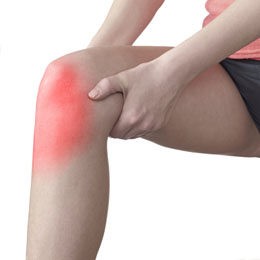Knee pain at night accompanied with limitations in knee movements is a common complaint in individuals with osteoarthritis. Other causes include certain types of knee injuries as well as benign bone tumors.

Knee pain is the most obvious symptom in many joint-related conditions and knee injuries. However, in certain conditions, this pain aggravates at night, leading to sleep disturbance and a lack of appropriate amount of sleep.
The most common reason for aching knees, especially at night, is osteoarthritis. However, other conditions like certain types of bone tumors may also lead to nocturnal knee pain.
Knee pain at night is often used as an important criterion in determining the extent of degeneration of the knee joint, and evaluating the need for a joint replacement surgery.
Some of the conditions that involve nocturnal knee pain have been described below.
Common Causes
OsteoarthritisAlso known as degenerative joint disease, this is the most common reason behind nocturnal knee pain. This condition is characterized by mild inflammation in the tissues around the joint, and damage of cartilages present in the bones. Although it can affect any joint of the body, knees and hips are the major sites. Overweight individuals as well as those above 50 years of age are more likely to be affected. Knee injury may also lead to the onset of osteoarthritis. The severity of knee pain may vary with weather conditions and the extent of physical activity and rest. Other symptoms include stiffness (especially in the morning), tenderness, and locking of knees.
Injury to the LigamentsThere are four types of ligaments in the knee - anterior cruciate ligament, posterior cruciate ligament, lateral collateral ligament, and medial collateral ligament. These ligaments are made up of fibrous tissues, and provide stability to the joint. Injury to these ligaments due to accidents, sudden twisting of the knee, or mishaps during any physical activity leads to pain and inflammation at the site of injury. This pain generally worsens at night.
Fat Pad IrritationThe infrapatellar fat pad, also known as Hoffa's pad, is a structure present at the base of the patella. It is the most sensitive structure of the knee. Sometimes, due to trauma or sudden movements, it may get impinged between the head of the thigh bone (femur's condyle) and the patella. This is referred to as fat pad irritation or Hoffa's syndrome, and leads to irritation and pain, which is severe when the knee is in the extended position. Hence, the severity of pain may be more while sleeping.
Osteoid osteomaThis is a rare type of benign (non-cancerous) bone tumor that mainly affects the long bones. The formation of such a tumor in the distal end of femur (thigh bone) leads to intermittent knee pain that increases at night. These tumors are generally less than 1.5 cm in diameter. Osteoid osteoma may develop between 5 and 25 years of age, and is more common in males.
Patellar TendinopathyInitially called 'jumper's knee', patellar tendinopathy is one of the most common reasons for sharp knee pain, especially among athletes involved in sports that require a lot of jumping. It is characterized by an injury to the patella, which leads to knee pain that aggravates while using the stairs, sitting for long periods, as well as while resting. The pain experienced at night may be severe enough to cause difficulty in falling asleep and sleep disturbance.
Plica syndrome, bursitis, Baker's cysts, meniscal tears, cat scratch disease are few other conditions which may involve knee pain at night. Several imaging techniques as well as physical tests may be used to diagnose the exact cause behind such pain. Imaging techniques are especially employed to detect the presence of tears and bone tumors.
The treatment to be employed depends on the exact etiology and may include analgesics, anti-inflammatory medicines, as well as certain minimally invasive techniques in case of lesions. Nevertheless, it is always advisable to seek appropriate professional consultation and investigate the symptoms further, rather than ignoring the pain or simply resorting to the use of pain-relieving medicines.
Disclaimer: This Buzzle article is for informative purposes only, and should not be used as a replacement for professional medical advice.


 Knee pain is the most obvious symptom in many joint-related conditions and knee injuries. However, in certain conditions, this pain aggravates at night, leading to sleep disturbance and a lack of appropriate amount of sleep.
Knee pain is the most obvious symptom in many joint-related conditions and knee injuries. However, in certain conditions, this pain aggravates at night, leading to sleep disturbance and a lack of appropriate amount of sleep.